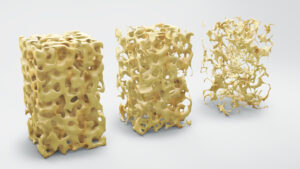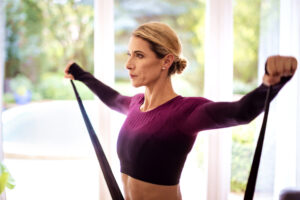1 in 2 women over the age of 50 are said to be suffering from osteoporosis. Nutritionist Natalie Rouse reveals her 4 essential tips on maintaining bone and muscle health during menopause
Many women experience bone and muscle weakness during menopause, with a significant number reporting these issues as primary health concerns.
Indeed, according to the National Osteoporosis Foundation, about 10 million Americans have osteoporosis, and 80 per cent of them are women, and according to the Royal Osteoporosis Society, approximately 3 million people in the UK have osteoporosis, with women are more commonly affected than men.
In fact, 1 in 2 women over the age of 50 are said to be suffering from bone fractures due to osteoporosis.
approximately 3 million people in the UK have osteoporosis
These statistics highlight the importance of addressing bone and muscle health as women approach and go through menopause.
Healthista spoke to Natalie Rouse, a registered nutritionist with over 22 years of experience. Natalie holds a First-Class Honours degree in Human Nutrition, a Master of Research, and is currently pursuing a PhD.
Natalie is also a qualified Exercise Physiologist with a background in sports and exercise science. Natalie’s expertise in nutrition and exercise provides valuable insights into maintaining bone and muscle health during menopause.
READ MORE: 7 pain management methods for Osteoarthritis

How menopause affects our bones and mucsles
‘Many of us are aware that the menopause brings hormonal changes, in particular, a drop in oestrogen levels,’ explains Rouse.
‘Oestrogen is a powerful anti-inflammatory hormone that helps protect bone density and muscle mass. As oestrogen levels decline, so does bone density, and muscle mass decreases, a process compounded by the natural ageing process and dietary habits. Plus, during menopause our bodies stop synthesising nutrients as they should, and therefore replenishment is pretty poor.
‘However, hormonal changes aren’t the only reason, lifelong dietary habits, such as cutting out dairy or red meat, can exacerbate bone and muscle decline, and of course ageing naturally reduces bone density and muscle mass.’
Signs of Osteoporosis and Muscle Weakness
Detecting early signs of osteoporosis can be challenging without medical screening (which they sometimes recommend to people who have had eating disorders), as symptoms often remain hidden until significant bone loss has occurred.
However, muscle weakness is more noticeable. From the age of 30, women lose about 1 per cent of muscle mass annually, a process accelerated by inactivity and poor diet.
symptoms often remain hidden until significant bone loss has occurred
‘We don’t usually notice signs of bone and muscle weakness straight away as it’s progressive and happens over time’, says Rouse.
‘If you go through your 20’s fit and healthy and resilient to everything, you may hit your 30’s and 40’s you still feel fine, and then usually it becomes apparent after some sort of health consequence. So unfortunately it’s not something we always recognise until it’s too late’.
Indicators of Muscle Weakness:
- Decreased Strength: noticeable decline in muscle strength and endurance.
- Increased Fatigue: muscles tire quickly during everyday activities.
- Frailty: increased frailty and difficulty in maintaining physical activities.
‘These days we’re all far more sedentary, especially for those of us who sit at a desk in the office all day’, adds Rouse.
‘Combine this inactivity with what we are or are not eating and we simply aren’t doing enough to keep our muscles stimulated, and if we’re not stimulated enough, biologically we’re not going to be holding onto that muscle.
READ MORE: 6 strength training benefits everyone should know about


So what mechanisms can we use to help prevent bone and muscle weakness as we age and reach menopause?
#1 Weight-Bearing Exercises
‘Weight-bearing exercises are crucial for maintaining bone density and muscle mass during menopause but also in general,’ explains Rouse.
‘Weight training is also beneficial for so many more things, such as helping to utilise blood glucose better (naturally our bodies don’t deal with glucose in the same way it used to when we hit Perimenopause), it helps to maintain bodyweight and decreases inflammation and stress, and it can even improve the health of our skin and hair.
‘Getting to the gym is a great option to begin using weights, and progressively move up the amount of weight in a controlled environment and with expert guidance, but for those who aren’t used to gyms, they can feel extremely daunting.
‘Trying to do more things and movements that your body isn’t use to is a great starting point
‘It’s never too late or too early to start weight bearing exercises, whenever you CAN start, then start.
‘Even beginning with lifting your arms up more than you usually would, if you’re not used to it, your arms will start to feel fatigued, it’s why some people notice tired arms when putting their hair up.
‘Trying to do more things and movements that your body isn’t use to is a great starting point.
‘Even Pilates can count as weight bearing exercises as you are using body weight and having to hold your body in a certain way that is putting strain on a muscle’.
Effective exercises include:
- Walking and Cycling: great cardiovascular exercises that also support bone health.
- Weight Training: essential for maintaining bone density and muscle mass. Start with light weights and gradually increase.
- Pilates: uses body weight to strengthen muscles and bones.
These exercises stimulate bone formation and help retain muscle mass, which is essential for overall health during menopause.
READ MORE: Weightlifting for women: PT reveals 6 benefits you need to know about
#2 Include an abundance of essential nutrients to your diet
A balanced diet rich in essential nutrients supports bone and muscle health during menopause.
‘When it comes to bone health and preventing osteoporosis, the main nutrient discussed is calcium, however vitamin D, phosphorus, magnesium and protein are equally essential,’ explains Rouse.
‘Indeed, European guidance for the diagnosis and management of osteoporosis in postmenopausal women recommends a daily intake of at least 1000 mg/day for calcium, 800 IU/day for vitamin D and 1 g/kg body weight of protein for all women aged over 50 years.
‘Yoghurt is my favourite food to recommend, it’s full of many of the vitamins and minerals your bones and muscles need to stay supported. Also, if you’re a meat eater, you can get an essential amount of protein from quality meat and dairy. Vegetarians can also up their protein intake when eating certain legumes, beans and pulses.
‘Try to avoid refined sugars where possible, as these foods can be extremely inflammatory and can exasperate menopausal symptoms, especially if you are prone to hot flushes, arthritis and joint pain.’
Recommended foods to include in your diet:
- Dairy Products: yoghurt and cheese provide a whole food matrix of essential nutrients.
- Lean Meats and Legumes: rich in protein, crucial for muscle maintenance.
- Oily Fish, Nuts, and Seeds: contain omega-3 fatty acids, which reduce inflammation and support cognitive health.
- Leafy Greens and Whole Grains: provide a variety of vitamins and minerals necessary for bone health.
READ MORE: How can vegans get enough calcium?


‘During menopause we also need to be adding foods that contain phytoestrogens,’ explains Rouse.
‘Phytoestrogens are naturally occurring oestrogens found in plants, that bind with oestrogen receptors to help to reduce signs and symptoms of menopause, when our oestrogen begins to plummet.
‘Phytoestrogens can be found in nuts, seeds (flax seeds) and soya products such as tofu. You can buy medicinal products to boost your intake of phytoestrogens, but I suggest eating as many leafy greens as possible as well as nuts and seeds.’
Here’s an example of what nutritionist Natalie Rouse eats in a day:
- Breakfast: eggs are fantastic or if I am in a rush I grab a full fat yoghurt (not the fat free versions) for protein, then I add some nuts and seeds or some Peachie granola, and for a bit of sweetness I drizzle over some honey or jam.
- Lunch: leafy green veggies and legumes with some protein (chicken or fish) and some carbohydrates for energy such as quinoa or wholegrain bread.
- Dinner: similar to lunch I will opt for leafy green veggies and legumes (cooked or raw) with some protein (chicken, fish or eggs).
- Drinks: plenty of water throughout the day and coffee – I am a huge coffee addict and the research looking into how coffee supports your microbiome is a win win for me.
- Snacks: nuts and seeds, some fruit.
For a nutritious and tasty addition to your diet, try Peachie Granola, £12.50 . It’s a delicious way to incorporate nuts and seeds into your meals, offering a blend of 14 essential nutrients, vitamins and minerals that support bone and muscle health during menopause.
Use HEALTHISTA3 for 15% off a month’s supply of Peachie or use HEALTHISTA1 for 5% off one pack of Peachie.
READ MORE: A Mediterranean diet is proven to ease these 5 menopause symptoms


#3 Intermittent Fasting (IF) can help manage symptoms
Intermittent fasting (IF) can be beneficial for managing menopause symptoms as it helps reduce inflammation, control blood pressure, and improve sleep quality.
‘Intermittent fasting is a useful tool that I think many tend to overthink and overcomplicate,’ says Rouse.
‘IF isn’t for everybody, some people wake up feeling absolutely ravenous, so eating breakfast as soon as they wake up is a must. Whereas others don’t feel hungry till later on – if this sounds like you, then I do recommend IF as it is a great tool in helping to reduce inflammation, and is also helpful for those who have high blood pressure or are struggling to sleep well.
Intermittent fasting (IF) can be beneficial for managing menopause symptoms as it helps reduce inflammation
‘A simple approach I like to recommend, is to stop eating by 7:30PM at dinnertime and resume eating with breakfast around 9 AM. This means you are sleeping through the majority of your fasting window.
‘During your ‘eating window’ focus on eating a whole food with a few treats here and there’.
#4 Sleep is king
‘For so many years, sleep was never the main focus when it came to health and wellbeing,’ says Rouse.
‘Thankfully now, people are starting to realise the true health benefits of getting seven to nine hours of sleep per night.
‘Sleep helps to reset so many different things, from our satiety hormones (leptin and ghrelin), to reducing stress and supporting neurological functions – all of which are crucial during menopause when sleep disturbances are common not thanks to those dreaded night sweats’.
Like this article? Sign up to our newsletter to get more articles like this delivered straight to your inbox.